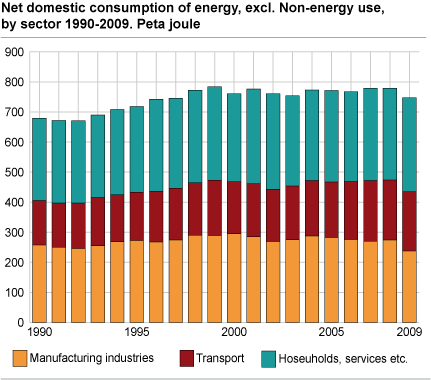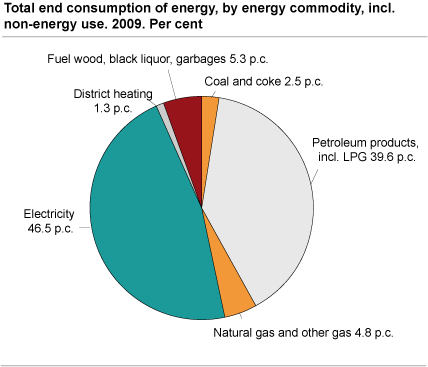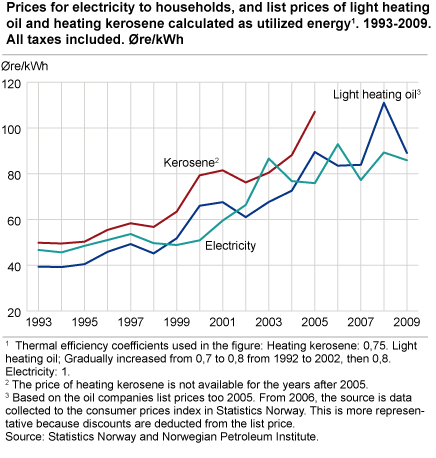Content
Published:
This is an archived release.
Significant drop in energy consumption in 2009
Preliminary statistics shows that the total end consumption of energy made up 747 Petajoule in 2009, which is 4 per cent less than the previous year, and the lowest consumption since 1997. The drop in consumption can be explained by the financial crisis and global economic recession, which has particularly affected the electricity intensive industry.
The electricity intensive industry is made up of industries with very high electricity consumption per produced unit. It comprises production of chemical industry and production of iron, steel and ferro alloys, aluminium and non-ferrous metals. Some manufacture of paper and paper products are also considered to be electricity intensive industry. These industries consume about a quarter of our total energy consumption, and their activity is therefore important for the total energy consumption. Their production is, to a large degree, aimed at the export market, which makes them more exposed to international economic cycles. Lower demand for steel and aluminium due to the financial crisis has contributed to lower prices on these products. This, combined with the repeal of many of their favourable cheap electricity contracts, has meant lower profitability and thereby lower production and energy needs in these industries. The energy consumption in the chemical and metal industry dropped in total by about 21 per cent from 2008 to 2009, while the consumption in manufacture of paper and paper products fell by about 7 per cent.
Reduced consumption also for non-energy purposes
Energy commodities used for non-energy purposes were also reduced in 2009, by about 16 per cent from 2008. If this is included in the total energy consumption, the decrease from the previous year becomes even larger. Non-energy use is for instance LPG used in production of chemical industry (for instance plastic), petroleum coke used in production of carbon anodes etc. It is mainly the electricity intensive industry that uses this. Total energy consumption including non-energy consumption made up about 818 Petajoule, which is 5.2 per cent lower than in 2008.
Lower energy consumption in transport but more use of biodiesel
The preliminary figures show that consumption for domestic transport purposes dropped by 2 per cent from the previous year. This is especially due to lower consumption of gasoline in road transport and heavy fuel oil in shipping. About 122 million litres of biodiesel were sold in 2009, which is 18 per cent less than the previous year. This made up about 4.8 per cent of diesel used for transport purposes in 2009. Some bioethanol was sold, but this makes up only a tiny fraction of the total sale of gasoline. Trade legislation was introduced for biofuels used in road transport, and the directed share rose from 2.5 per cent to 3.5 per cent from 1. April 2010, and will probably increase to 5 per cent in January 2011.
Higher energy consumption in other sectors
In other sectors (private and public services, households, construction and defence), the energy consumption rose by 2 per cent from 2008 to 2009. This can be explained by the fact that it was somewhat colder in 2009 than in the previous year. The energy consumption in these sectors is more dependent on the temperature than the manufacturing industries, but economic activity, growth in demand and population are also important. The temperature in 2009 was 1oC above the climatic normal for the total year and 1.4oC above normal in 2008. The winter 2009/2010 was cold, but especially from January and afterwards, so it doesn’t affect the 2009 figures. The electricity prices for households was 86 øre/kWh on average in 2009, which is somewhat lower than in the previous year, but still high compared to the electricity prices we have traditionally had in Norway.
Lower energy production
Our total production of primary energy commodities (coal, crude oil, fuel wood, natural gas, hydro and wind power) made up 9021 Petajoule in 2009, which is scarcely 2 per cent lower than in 2009. The decrease is mainly due to lower oil production (crude oil, NGL, condensate), which came to 109 million tonnes. This is 5 per cent lower than in 2008
Norway is a large energy producer, and we produce more than 10 times more energy than we consume. The main part is exported, and because of this, energy is an important source of income. The production of natural gas (excl. gas that is flared off) rose by scarcely 4 per cent and came to 106 billion Sm3. Nevertheless, the total value of oil and gas production was significantly lower than in 2008. This can also be explained by the international recession and lower oil demand due to the financial crisis, which resulted in lower oil and gas prices than in 2008.
Tables:
- Table 1 Energy sources balance sheet for Norway. 2009
- Table 2 Energy sources balance sheet for Norway. 2008
- Table 3 Energy balance sheet for Norway. 2009. Petajoule
- Table 4 Energy balance sheet for Norway. 2008. Petajoule
- Table 5 Net consumption of individual energy bearers. 1976-2009
- Table 6 Energy balance, total energy 1998-2009. GWh
- Table 7 Supply and use of electricity 1998-2009. GWh
The statistics is now published as Production and consumption of energy, energy balance and energy account.
Additional information
The statistics are published in spring and autumn. The spring publication is preliminary and aggregated to a larger degree, and only includes figures for energy balance. In the autumn publication, tables are also presented for the energy accounts.
Contact
-
Statistics Norway's Information Centre
E-mail: informasjon@ssb.no
tel.: (+47) 21 09 46 42




